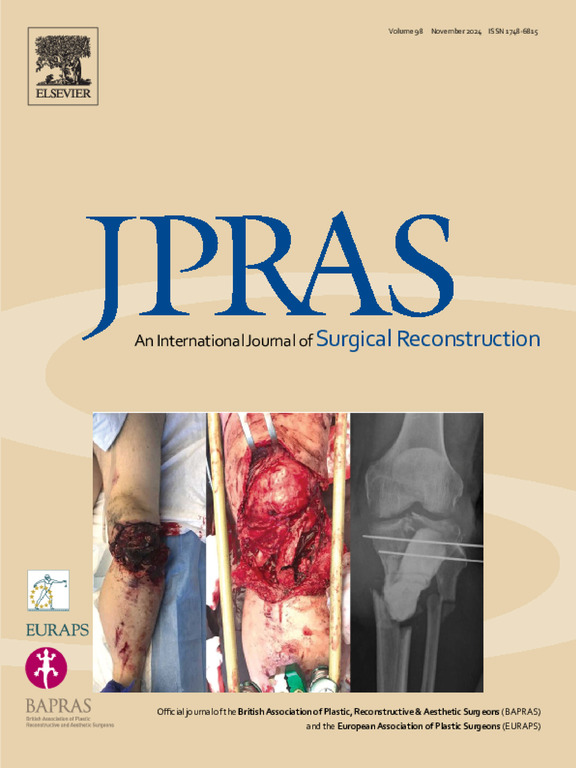Optimization of autologous adipose tissue transplantation: The impact of patient-specific and intraoperative factors on cellular viability before and after cryopreservation
IF 2.4
3区 医学
Q2 SURGERY
Journal of Plastic Reconstructive and Aesthetic Surgery
Pub Date : 2025-07-29
DOI:10.1016/j.bjps.2025.06.049
引用次数: 0
Abstract
Background
Autologous adipose tissue transplantation is a versatile surgical procedure used for aesthetic, reconstructive, and regenerative purposes. Cryopreservation of adipose tissue collected during liposuction reduces the need for repeated fat collection, minimizing patient discomfort while preserving volumetric and regenerative properties.
There are currently no studies in the literature correlating cellular viability, before and after thawing, with patient-specific variables and collection techniques.
This study investigates patient-specific factors affecting cellular viability before and after thawing to refine protocols for patient selection and tissue collection.
Materials and methods
A retrospective analysis of 55 patients from the University Hospital Policlinico of Modena was conducted. Intraoperative factors (disinfectant used, type of anesthesia, operators, associated procedure, duration of surgery, harvesting area, quantity collected) and clinical variables (age, sex, smoking status, comorbidities, antiblastic therapy, hormonal therapy, radiation therapy, immunological therapy) were analyzed. Cell count and metabolic activity tests were performed pre- and post-cryopreservation.
Results
Hormonal therapy significantly correlates with reduced cellular metabolic activity and viability, both pre- and post-thawing.
Conclusions
The findings underscore the need to evaluate adjuvant therapies when planning adipose tissue collection. Optimizing timing and preparation can improve graft viability, reducing resorption rates and enhancing volumizing and regenerative effects.
Preoperative planning must account for the timing of hormonal and other therapies to ensure effective autologous adipose transplants with improved outcomes
自体脂肪组织移植的优化:患者特异性和术中因素对冷冻保存前后细胞活力的影响。
背景:自体脂肪组织移植是一种多用途的外科手术,用于美容、重建和再生目的。在吸脂过程中收集的脂肪组织冷冻保存减少了重复收集脂肪的需要,最大限度地减少了患者的不适,同时保留了体积和再生特性。目前文献中还没有将解冻前后的细胞活力与患者特异性变量和收集技术联系起来的研究。本研究探讨了影响解冻前后细胞活力的患者特异性因素,以完善患者选择和组织收集的方案。材料与方法:回顾性分析摩德纳大学医院55例患者的临床资料。分析术中因素(使用的消毒剂、麻醉类型、操作人员、相关程序、手术时间、采收区域、采收数量)和临床变量(年龄、性别、吸烟状况、合并症、抗肿瘤治疗、激素治疗、放射治疗、免疫治疗)。在冷冻保存前后分别进行细胞计数和代谢活性测试。结果:激素治疗与解冻前和解冻后细胞代谢活性和活力的降低显著相关。结论:研究结果强调了在计划脂肪组织收集时评估辅助治疗的必要性。优化时间和准备可以提高移植物活力,降低再吸收率,增强体积和再生效果。术前计划必须考虑到激素和其他治疗的时机,以确保有效的自体脂肪移植和改善的结果。
本文章由计算机程序翻译,如有差异,请以英文原文为准。
求助全文
约1分钟内获得全文
求助全文
来源期刊
CiteScore
3.10
自引率
11.10%
发文量
578
审稿时长
3.5 months
期刊介绍:
JPRAS An International Journal of Surgical Reconstruction is one of the world''s leading international journals, covering all the reconstructive and aesthetic aspects of plastic surgery.
The journal presents the latest surgical procedures with audit and outcome studies of new and established techniques in plastic surgery including: cleft lip and palate and other heads and neck surgery, hand surgery, lower limb trauma, burns, skin cancer, breast surgery and aesthetic surgery.

 求助内容:
求助内容: 应助结果提醒方式:
应助结果提醒方式:


